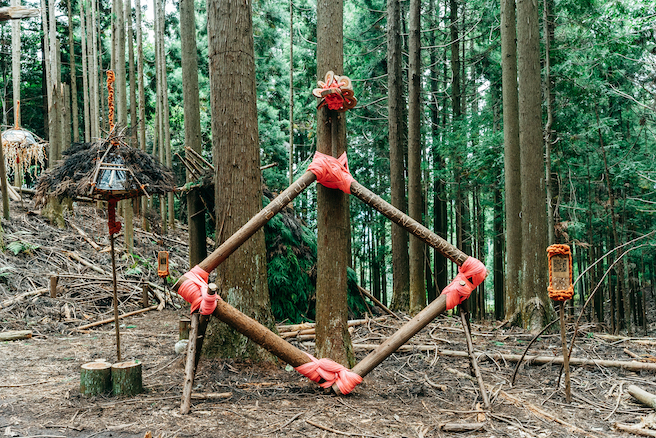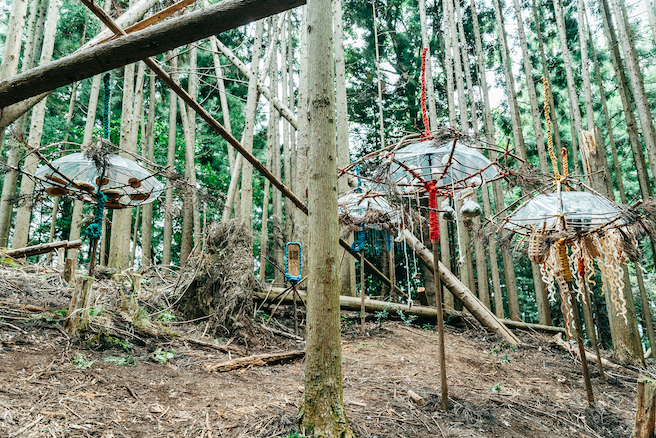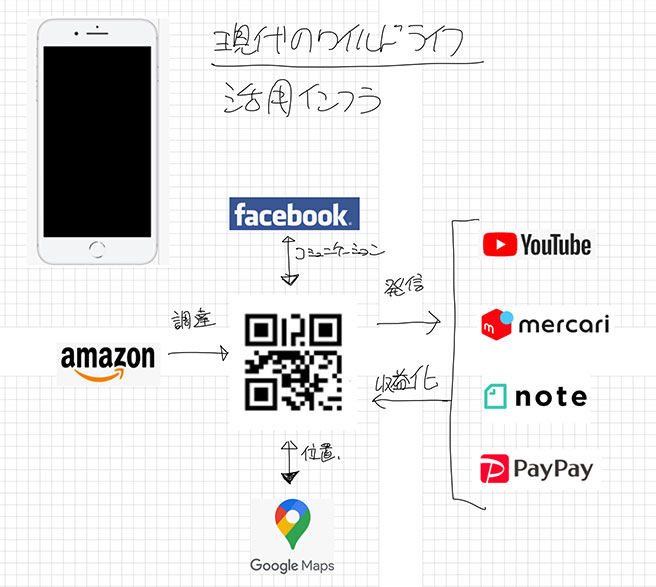 Installation view.
Installation view.
展示風景。
 Address and Post
Address and Post
As a marker for a dwelling in the vast mountains, a braided cedar trunk, which has been cut down and is lying on the ground, has been carved and set with a GPS number for that location.Deliveries are delivered to this address and placed in an adjacent post box.
《住所とポスト》
広大な山の中での住居の目印として、伐採され地面に転がる杉の幹を編組し、その地点の GPS 数値を彫って打ち立てた。この数値を住所として配達物が届き、隣のポストに入れられる。
 Shelter
Shelter
A fallen tree from a typhoon a few years ago was used as a support, and countless braided branches were covered with leaves. As the season changed from summer to autumn, the colour of the leaves also changed.
《シェルター》
数年前の台風による倒木を支柱にして、枝打ちされた枝を無数に編組し葉で覆った。夏から秋へと季節が変わる中、葉の色合いも変化していった。
 Faith
Faith
Living alone in the mountains is lonely and uneasy. In order to feel the presence of people, I knitted several motifs of human faces out of familiar materials and decorated them by the shelter to pray for peace and quiet.
《信仰》
山でのひとり暮らしは孤独で不安だ。そこで人の気配を感じられるよう、普段から馴染みのある素材で人の顔をモチーフにしたものを複数編みシェルターの側に飾り、安寧を祈ることにした。
 Shelves made from discarded plastic umbrellas and branches. Stores knitting needles made of branches and other productions.
Shelves made from discarded plastic umbrellas and branches. Stores knitting needles made of branches and other productions.
廃棄されたビニール傘と枝で作った棚。枝製の編み針や、制作物を収納。
 Suit
Suit
The garment was made by weaving the face skin, which can only be peeled from Yoshino cedar, which has fine, uniform annual rings. The suit, which naturally forms a sphere due to the tension of the material, can maintain a social distance and protect against various dangers in the mountains. The cedar also has antibacterial properties, so masks were also manufactured. When the lush leaves lose their colour, it is a sign to change the filter.
《スーツ》
年輪が細かく均一な吉野杉でしか剥ぐことのできない面皮を編んで衣服を作った。素材の張りによって自然と球体になったスーツはソーシャルディスタンスも保つことができ、山での様々な危険から身を守ってくれる。杉には抗菌作用もあるため、マスクも製造。青々とした葉が色を失ってきたらフィルター交換のサイン。
 Storage space for suits.
Storage space for suits.
スーツ置き場。
 Kuzu Pottery
Kuzu Pottery
Yoshino is a production area of kuzu. The kuzu becomes transparent when heated and hardens to a cloudy white when cooled, and its appearance is reminiscent of soda glass. Kuzu, with its high nutritional value, can also be used as emergency food.
《葛器》
吉野は葛の産地。加熱で透明になり冷却すると白濁し固まるという葛の性質や見た目がソーダガラスを想起させることから、器を作り工芸品として販売することにした。栄養価の高い葛は非常食にもなる。
 Garbage and Mountain Potpourri
Garbage and Mountain Potpourri
Rubbish brought from the city, such as sweets packages that have fallen in the mountains, is made into fibres and woven into a potpourri by stuffing shavings of Yoshino cypress inside. The products are sold on Mercari(Japan Shopping proxy services) in order to return the rubbish to the city and for people who are tired of city life.
《ゴミと山のポプリ》
山に落ちているお菓子のパッケージなど都会からもたらされたゴミを繊維状にして編み、中に吉野ヒノキの削り節を詰めてポプリにした。ゴミを都会に戻すため、そして都会の生活に疲れた人のためにメルカリで販売。

1st-5th Photo: Yuta Togo
6th-8th Photo: Koichiro Kutsuna
Six QR codes were placed in the living spaces, allowing visitors to catch a glimpse of the way of life through movies, images and text.
居住空間には 6 つの QR コードを設置し、訪門者はその生活ぶりを映像などで垣間見ることができるようにした。
 Pre-production idea note.
Pre-production idea note.
制作前のアイデアメモ。

Mercari sales screen.
メルカリ販売画面。
The IT infrastructure was fully utilised, as it is a modern wild life. Communication was done via SNS such as Facebook and Instagram, and daily life was posted on note(Japanese media platform). As part of the cycle of survival, they make ‘kudzu vessels’ and ‘potpourri from rubbish and mountains’ in the mountains and sell them on Mercari, and use the money earned from the sales to buy food and other minimum necessities on amazon.
現代のワイルドライフということで、ITインフラをフルに活用。コミュニケーションはfacebookやインスタグラムなどのSNS、日々の暮らしの様子はnoteにて発信した。
生きていくためのサイクルとしては、山で《葛器》や《ゴミと山のポプリ》を作りメルカリで販売し、売れて得たお金で食料など必要最低限のものをamazonで購入。
——————————–
2020
Yoshino cedar, Yoshino hon-kuzu, umbrellas, cardboards, Yoshino cypress, garbage, kozo, cotton yarn, acrylic yarn
Mt. Yoshino, Nara, “OKUYAMATO MIND TRAIL Museum in your mind”
2020年
吉野杉、吉野本葛、傘、段ボール、吉野ヒノキ、ゴミ、楮、綿糸、アクリル毛糸
奈良県吉野山「MIND TRAIL 奥大和 心のなかの美術館」にてインスタレーション
——————————–
Living spaces and clothing are created by weaving mountain materials, and living infrastructures are built using the latest IT technology. This work is based on the hypothesis of ‘living in the mountains where social distance can be maintained’.
As the COVID-19 pandemic made it impossible to create the work of knitting and wrapping a city in collaboration with many people, the project returned to the origins of knitting as a technique for making daily necessities, and attempted to use it as a way of living in the present.
In a situation where everyone is forced to change their lifestyle, it may be possible to survive in the world of the future by once again utilising one’s abilities and experiences in a different way from the past.
山の素材を編んで居住空間や衣服を作り、最新 IT 技術により生活インフラを構築。「ソーシャルディスタンスを保つことができる山の中で生活する」という仮説の作品。
コロナ禍により多くの人と協働して街を編み包むという作品が作れなくなってしまったことで、生活用品を作るための技術という編み物の原点に立ち戻り、今を生きる術としての活用を試みた。
誰もがこれまでの生活様式を変えざるを得ない状況で、今一度自分が有する能力や経験を従来とは異なる形で活かしていくことで、これからの世の中を生き延びることができるのかもしれない。